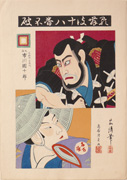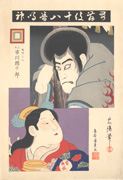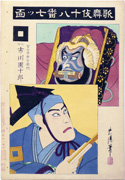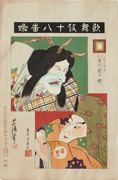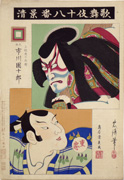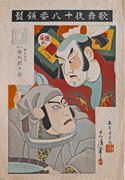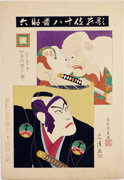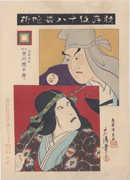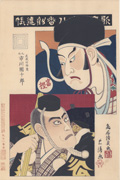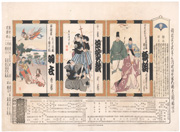Prints in Collection
Prints from the series The Kabuki Eighteen (Kabuki Jūhachiban)
IHL Cat. #1272 | in the play Narukami, 1896 IHL Cat. #991 |
IHL Cat. # #723 | Ichikawa Danjūrō IX as Teruhi no Miko in the play Uwanari, 1896 IHL Cat. #1510 | Ichikawa Danjūrō IX as Kazusa Akushichibei in the play Kagekiyo, 1895 IHL Cat. #722 | Yamanoue Gennaizaemon in the play Zohiki, 1896 IHL Cat. #724 |
IHL Cat. #990 | Ichikawa Danjūrō IX as Hanakawa Toagemaki no Sukeroku in the play Sukeroku,1896 IHL Cat. #471 | Ichikawa Danjūrō IX as Suhama Sōzu in the play Jayanagi, 1896 IHL Cat. #992 | Ichikawa Danjūrō IX as Musashibō Benkei in the play Kanjinchō, 1896 IHL Cat. #1255 |
Biographical Data
Biography
Torii Kiyotada (Torii VII) 鳥居清忠 (七代目) (1875-1941)Sources: A Dictionary of Japanese Artists: Painting, Sculpture, Ceramics, Prints, Lacquer, Laurance P. Roberts, Weatherhill, 1976, p. 183; Guide to Modern Japanese Woodblock Prints: 1900-1975, Helen Merritt, University of Hawaii Press, 1992, p. 155; Modern JapaneseWoodblock Prints - The Early Years, Helen Merritt, University of Hawaii Press, 1998, p. 82. and as footnoted.
Torii Kiyotada VII was born in Edo (Tokyo) with the given name Saitō Chōkichi 斎藤 長吉. His father was the artist Torii Kiyosada (1844-1901). Torii Kiyotada VII was the fourth of the Kiyotada name and the seventh generation of Torii family printmakers for the kabuki theater. At the age of eighteen he studied Tosa-style painting with Kawabe Mitate (1837-1905), but four years later "he returned to the family tradition, and dedicated himself to mastering the Torii style under the guidance of Kiyosada...."1 Like his father he had a close association with Kabuki (himself, being an amateur actor), creating actor pictures and theater advertisements for the Kabuki-za, Shintimo-za, Meiji-za and Imperial Theater. He also created prints of the Russo-Japanese War (1904-1905).
Artist names (gō) used by Kiyotada include Tadakiyo 忠清, Jusoso Takdakiyo, Kiyotada 清忠, Gekigadō 劇雅堂, Kunsai 薫斎, Manjinoya 卍廼舎, Nanryō 南陵, and Suisha 酔舎. The Museum of Fine Arts, Boston shows the artist's name as "Hasegawa Kanpei XIV (Tadakiyo)".
His adopted son, Saitō Akira, was the famous shin hanga print artist Torii Kotondo (Torii VIII) (1900-1976). Ueno Tadamasa (1904-1970), a student of Kiyotada’s, was authorized by the Torii family to use the name of Torii Tadamasa in 1949.
Torii Kiyotada’s most famous works are his 1895-1896 series of actor prints created with his father Torii Kiyosada titled Kabuki jūhachiban (The Kabuki Eighteen), illustrating characters in each of eighteen plays selected by Ichikawa Ebizō V (Ichikawa Danjūrō VII) in 1840 as the most representative aragoto (rough-stuff) plays of the Ichikawa Danjūrū line of actors.2 Lawrence Smith writes that "The portfolio seems have been designed by Kiyotada using original sketches by his father Kiyosada, who was a contemporary of Danjūrō."3 He also designed a second series around Kabuki jūhachiban that was sold by subscription by Oana Shūjirō of Shūbisha, with two prints appearing each month over a period of nine months from 1926-1927.
1 "Enduring Alliance: The Torii Line of Ukiyo-e Artists and Their Work for the Kabuki Theater," Money L. Hickman appearing in Fenway Court 1992, Trustees of the Isabella Steward Gardner Museum, 1993
2 for a listing of the plays see the Kabuki 21 website http://www.kabuki21.com/glossaire_4.php
3 The Japanese Print Since 1900: Old dreams and new visions, Lawrence Smith, British Museum Publications Ltd., 1983, p. 76.
last revision:
3 The Japanese Print Since 1900: Old dreams and new visions, Lawrence Smith, British Museum Publications Ltd., 1983, p. 76.
last revision:
3/2/2020

